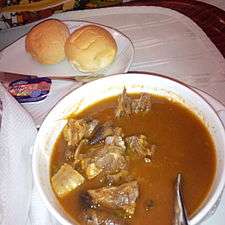Goat meat pepper soup
Goat meat pepper soup, also referred to as nwo-nwo,[1] ngwo-ngwo,[2] and goat pepper soup,[3][4] is a soup in Nigeria. Goat meat is used as a primary ingredient, and some versions may use crayfish.[5][6] For variations boiled yams, potatoes, or plantains may be added. Versions of the soup may be spicy and hot.[2][6] The soup is always served hot and is made with a blend of different spices which gives an intense spiciness and flavor to the soup.[7] The dish has been described as being the most popular out of all the Nigerian pepper soups.[1] It is a light soup that is often prepared without the use of oil,[8] and may also be drunk in the style of a beverage.[2] It is sometimes accompanied with eba, rice or pounded yam.[8] It has been described as pairing well with palm wine and beer.[1]

History
Goat meat pepper soup is eaten year round in Nigeria, during hot or cold seasons. It is claimed to help ease a flu[8] or cold if it is cooked the proper way. If assorted parts of the goat are used, certain pieces may need to be cooked longer than others.[5]
There are different varieties of pepper soup which vary according to region, with different combinations of spices.[9] For instance, the Igbo people, in the east, and Riverians in the southeast, prepare their pepper soup with tomatoes, onions and spices. Those of Delta origin sometimes prepare the pepper soup with ataiko, uda, gbafilo, rigije, and lemon grass leaves. In Yoruba, goat meat pepper soup is sometimes referred to as Oggun.
Preparation
There are many different ingredients used depending on the region and availability. Common ingredients in goat meat pepper soup are goat meat,[2] crayfish, Uziza, Negro Pepper (also called Uda Ewentia or Enge) and nutmeg,[8] such as Calabash Nutmeg (also called Ehu or Ariwo). Other ingredients that are commonly used when access to traditional ingredients is limited are bouillon cubes, onion,[2] salt, pepper, basil and chili pepper.[5] Some versions also use a goat's head.[8] Preparation involves cleaning and seasoning the meat and simmering with chopped onions, after which water is added and the dish is further cooked. The dish may be finished with seasoning such as salt, pepper and basil.[5]
See also
References
- Evans, D.L. The Recipes of Africa. Dyfed Lloyd Evans. pp. 105–106.
- Jideofo, May (2007). "Healthier Alternatives". Tate Publishing. p. 35. ISBN 1602478058.
- Klein, Michael (26 May 2015). "A traveling Nigerian chef to cook pop-up dinner". Philly.com. Retrieved 26 May 2015.
- Strachan, Sue (22 October 2014). "Lagos pop-up dinner brings the food of Nigeria to New Orleans". NOLA.com. Retrieved 26 May 2015.
- Nky Lily Lete. "Nigerian Goat Meat Pepper Soup". nigerianfoodtv.com. Retrieved 26 May 2015.
- Cook, Phaedra (4 July 2011). "100 Favorite Dishes: No. 79, Goat Pepper Soup at Peppersoup Cafe". Houston Press. Retrieved 26 May 2015.
- "Nigerian Pepper Soup". Avartsycooking.com. 27 February 2012. Retrieved 5 June 2015.
- Asika-Enahoro, Chidi (2004). "A Slice of Africa". iUniverse. p. 17. ISBN 0595305288.
- Kitchen Butterfly (1 March 2011). "How To Make Nigerian Pepper Soup". Kitchen Butterfly. Retrieved 26 May 2015.
Further reading
- Martineau, Chantal (4 June 2010). "Buka Invites You to Sweat It Out Over Nigerian Pepper Soup". Village Voice. Retrieved 26 May 2015.CS1 maint: ref=harv (link)
External links
- How to cook Nigerian Pepper Soup. Allnigerianrecipes.com.
- Avartsycooking.com